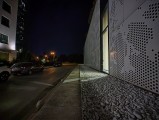Nothing Phone (1) review

Dual 50MP camera on the back
The Nothing Phone (1) packs two 50MP cameras on its back - one for standard and one for ultrawide-angle photos. A 16MP camera sits across the opposite side for selfie purposes. The phone comes with a single-LED flash, you can also use the Glyph fill lights in most cases, and there is a small red light you can turn on when recording videos.

The primary camera on the Nothing Phone (1) utilizes a 50MP Sony IMX 766 1/1.56" Quad-Bayer sensor with 24mm f/1.88 optically stabilized lens, 1.0µm pixels (2.0µm after 4-to-1 binning), and PDAF. This camera shoots by default in 12.5MP.
The ultrawide camera uses a 50MP Samsung JN1 sensor with a Tetracell color filter (Samsung's speak for Quad Bayer). This one is noticeably smaller than the primary 50MP sensor - 1/2.76" type with 0.64µm pixels (1.28µm after the 4-to-1 binning). The sensor sits behind a 14mm f/2.2 lens; automatic distortion correction is always in play. This camera supports PDAF and can focus as close as 4cm away - meaning you can shoot macro with it, and a dedicated macro mode is available.
Both the primary and the ultrawide cameras support an automatic Night Mode of sorts. When the scene is suitable for Night Mode - a moon icon will appear on the viewfinder, but you need to tap it to activate Night Mode. It usually uses 4s-5s exposure time on both cameras. There is no other way to access the Night Mode.

The front camera relies on a 16MP Sony IMX471 1/3.1" sensor with 1.0µm pixels and a Quad-Bayer color filter. It still saves images at the nominal 16MP resolution, which might compromise the quality if you examine the photos up close. The lens is 24mm with an f/2.45 aperture. Autofocus isn't available for selfies.
Camera app
The default Camera app is close to what you'd find across the latest Realme, and OnePlus smartphones use. Swiping on the viewfinder or the scroller below switches between modes, while the additional ones can be found under the "More" sub-menu.

Flash and timer are available on the left side, but you can expand more settings like resolution (12MP/50MP), aspect, Filters, Live Photo, and advanced settings.
Expert mode is also available, and it works on both cameras. The shutter speed can be as low as 30s for the main camera and 20s for the ultrawide cam. RAW capturing is available, too.
Night Mode can work on videos, too, but it's only for the main camera and drops the resolution down to 1080p at 30fps.
You can use either LED flash or the Glyph LEDs across a variety of occasions like video capturing, portraits, photos.
Photo quality
Important: Our Nothing Phone (1) unit received two major updates during the review process – both improving on battery life, Glyph UI, and camera performance. Our review is based on the latest version of Nothing OS – 1.1.0. This recent update indeed improved on the photo quality (mostly with better noise reduction and more consistent color presentation), and we would advise the early adopters to update to the most recent firmware available if not already.
The main camera on the Nothing Phone (1) saves 12.5MP photos by default, which turned out pretty well. There is a lot of resolved detail, the sharpening is not over the top, and the foliage is well-developed. The colors are realistic, even if a tad over-saturated.
We can also praise the contrast and the natural-looking dynamic range (meaning good, but not extreme). Also, the noise is low across all photos, and we think Nothing has done a very good job with the processing, especially since this is their first smartphone.
It appears that our unit has a lens issue on the primary camera that makes for a blurred spot around the middle-left part when focusing at infinity. We think this is a unit-specific problem and not a widespread issue, as the second unit we had (but returned, unfortunately) had no such thing.
The Nothing Phone (1) viewfinder has a dedicated 2x zoom shortcut even if there is no telephoto camera available. The digital zoom, while not considered lossless, is still of high quality as it does more than just a simple crop and upscale.
The 2x zoomed photos aren't as sharp as the default photos, but they present a higher than expected level of detail, and the rest matches the main samples - colors, contrast, dynamic range, and noise.
The portraits taken by the main camera are outstanding - the subjects are well-exposed, nicely detailed and clean of noise. Their separation from the background is quite accurate, even though there is no depth sensor on the phone.
The (adjustable) simulated blur is lovely, too. And we found the colors and contrast easily likable. Indeed, these are some of the better portraits we've seen in a while.
You can switch to a 50MP shooting mode, but it appears it offers 50MP upscales from the default photos.
The 50MP ultrawide camera also outputs 12.5MP photos by default, and the field of view is indeed incredibly wide. The photos have respectable (for an ultrawide-angle camera) resolved detail, likable contrast, and praise-worthy automatic distortion correction. The noise reduction works well, too.
The dynamic range is average most of the time, even if the automatic HDR decided to trigger (recognizable by a small drop in sharpness and a somewhat overprocessed look).
This camera offers realistic colors, sometimes even slightly desaturated. You can easily spot the big difference between the color presentation on the main and ultra-wide cameras. While we received an update that was supposed to fix this (OS 1.1.0), the difference is still obvious. We hope Nothing works on improving them furthermore.
Overall, we are happy with the ultrawide photos as they are of high quality with a ton of resolved detail.
The ultrawide camera supports autofocus, and that's why you can also shoot closeups from 4cm away. These are sharp enough, with pleasant colors and contrast. The noise is low. And if the light isn't enough, you can use the Glyph LEDs to improve it.
We would like to suggest using the main camera instead, as it offers much more natural bokeh (f/1.88 aperture), and it will also offer a more bright, detailed, and colorful photo. Sure, its focus limit is about 10cm, but as you can see - the photos are quite likable.
Finally, you can also shoot 50MP photos with the ultrawide camera, too. And just like the ones from the main shooter, these are simple upscales from the regular images.
The 16MP selfie camera uses a sensor with a Quad-Bayer filter, meaning its default resolution should be 4MP. It is not, though. The processing upscales the photos back to 16MP, and that's why none of the selfies look perfectly sharp.
They are still pretty good, though. There is enough detail not to call them soft, while everything else is great - colors, contrast, dynamic range, and noise reduction.
The selfie portraits offer proficient enough separation, pleasant blur, and colorful and well-developed subjects.
Low-light photo quality
There is Night Mode available to all cameras, but its trigger appears only when the conditions are suitable for Night Mode (meaning in low light). You cannot control its exposure time (usually 5s); you can just choose whether to use it or not.
So, the standard low-light photos from the main camera are excellent. They offer true to life look with realistic exposure and acceptable dynamic range. The resolved detail is plenty, the color saturation is pretty good, and the noise reduction strikes the perfect balance between noise and detail.
Some blown highlights are noticeable but other than that - these are some solid low-light samples!
The Night Mode improves the exposure and makes for slightly brighter photos with punchier colors. It exposes more detail in some shadows and reduces the blown highlights. While a bit unrealistic, the Night Mode photos are probably the ones, you'd want to share with your friends.
The 2x zoomed samples shot without Night Mode are pretty good - they are bright, colorful, sharper than expected, and with well-handled noise. Some smart upscale seems to be at play here, and we do like the result and suggest using zoom if the scene needs it.
Using Night Mode on the 2x zoom level will drastically lower the detail, and the images become incredibly soft. They get improved exposure and colors, but we don't think it's worth losing all the sharpness.






Main cam 2x zoom with Night Mode
The default ultrawide photos taken at low light are great, speaking volumes for the quality of the camera and its processing. There is more than enough resolved detail; the color saturation is kept natural, and so is the brightness. The noise reduction is once again spot on - not too harsh and not too gentle.
The Night Mode drastically improves the exposure of the ultrawide photos and boosts the colors, but at a price - a noticeable drop in the resolved detail, overprocessed look and visible image artifacts.










Ultrawide camera with Night mode
And here are photos of our usual posters taken with the Nothing Phone (1). You can see how it stacks up against the competition. Feel free to browse and pit it against other phones from our extensive database.



Nothing Phone (1) against the Galaxy A52s 5G and the Poco F4 GT in our Photo compare tool
Video quality
The Nothing Phone (1) captures videos with all its cameras. The main and ultrawide cameras record videos up to 4K at 30fps, and there's 1080p at both 30fps and 60fps. The selfie shooter is limited to 1080p@30fps video capturing.
You get the option to choose between the h.264 and h.265 codecs.
Electronic stabilization is available - it is optional for all rear cameras and works on all resolutions and frame rates. The primary camera also benefits from OIS.

The Nothing Phone (1) is quite generous with the bitrates - the 4K footage gets 57Mbps, while 1080p/30fps is allocated a similarly above-average 20Mbps when using the h.264 codec. The audio bitrate is about 96kbps. The sound is stereo. Despite the seemingly low bitrate, the sound appears to be good, if not great.
The 4K clips we shot on the main camera are great - they offer plenty of resolved detail but with the right amount of sharpness and make for a natural look. The noise is low, the colors are lively and true to life, and the dynamic range deserves praise.
Do not forget that the primary camera on our unit has a lens issue; that's why you can see a soft spot on the left part of the video.
You can shoot 2x zoomed videos, but they are a simple digital zoom, and while sharing all the good qualities with the standard clips, the resolved detail is halved.
The 4K videos from the ultrawide camera are pretty good, too. There is a lot of resolved detail, the contrast is okay, and the noise is low. The dynamic range is average, and the colors are a bit muted, but overall - the video quality is solid, especially for an ultrawide-angle camera.
The 4K clips from the main camera at night are okay with enough detail, realistic exposure and colors. The noise is handled well.
Night Mode video is always shot on the main camera and in 1080p resolution at 30fps. It offers an improved exposure resulting in a brighter picture, and the color looks a bit better.
The low-light videos from the ultrawide camera are rather dark (because of the f/2.2 lens) but are not ruined by noise. If there is a certain occasion at night where you need to shoot with this camera, it will produce usable footage.
Finally, here is the Nothing Phone (1) in our video tool so you can make your own comparisons.



2160p: Nothing Phone (1) against the Galaxy A52s 5G and the Poco F4 GT in our Video compare tool
Reader comments
- Gghj
- 04 Oct 2024
- mZD
How?
- rafnov
- 09 May 2024
- L66
The most mistaken design I have ever seen. Ever. It is terrible nonsense that makes me puke.
- Ashish
- 03 Feb 2024
- GQ2
Video camera 4k 60 fps available






























































































































